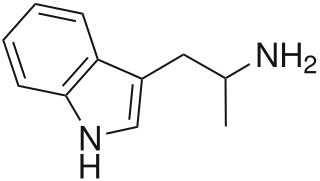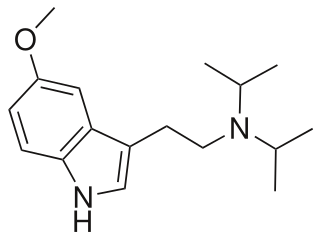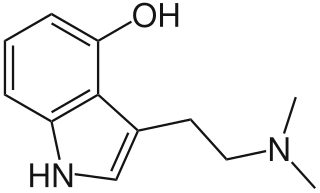
α-Methyltryptamine is a psychedelic, stimulant, and entactogen drug of the tryptamine class. It was originally developed as an antidepressant by workers at Upjohn in the 1960s, and was used briefly as an antidepressant in Russia under the trade name Indopan before being discontinued.

5-Methoxy-N,N-diisopropyltryptamine is a psychedelic tryptamine and the methoxy derivative of diisopropyltryptamine (DiPT).

5-MeO-aMT or 5-methoxy-α-methyltryptamine, α,O-Dimethylserotonin (Alpha-O) is a potent psychedelic tryptamine. It is soluble in ethanol.

4-Hydroxy-N,N-diisopropyltryptamine is a synthetic psychedelic drug. It is a higher homologue of psilocin, 4-HO-DET, and is a positional isomer of 4-HO-DPT and has a tryptamine molecular sub-structure.

Psilocin is a substituted tryptamine alkaloid and a serotonergic psychedelic substance. It is present in most psychedelic mushrooms together with its phosphorylated counterpart psilocybin. Psilocin is a Schedule I drug under the Convention on Psychotropic Substances. The mind-altering effects of psilocin are highly variable and subjective and resemble those of LSD and DMT.

Diisopropyltryptamine is a psychedelic hallucinogenic drug of the tryptamine family that has a unique effect. While the majority of hallucinogens affect the visual sense, DiPT is primarily aural.

4-HO-DET, also known as 4-hydroxy-diethyl-tryptamine, CZ-74, is a hallucinogenic drug and psychedelic compound of moderate duration. 4-HO-DET is a substituted tryptamine, structurally related to psilocin, ethocybin, and 4-HO-DIPT.

4-Acetoxy-DET (4-Acetoxy-N,N-diethyltryptamine), also known as ethacetin, ethylacybin or 4-AcO-DET, is a psychedelic tryptamine. It was first synthesized in 1958 by Albert Hofmann in the Sandoz lab.

5-MeO-MiPT is a psychedelic and hallucinogenic drug, used by some as an entheogen. It has structural and pharmacodynamic properties similar to the drugs 5-MeO-DiPT, DiPT, and MiPT. It is commonly used as a "substitute" for 5-MeO-DiPT because of the very similar structure and effects.

5-MeO-DALT or N,N-di allyl-5-methoxy tryptamine is a psychedelic tryptamine first synthesized by Alexander Shulgin.

4-HO-MiPT is a synthetic substituted aromatic compound and a lesser-known psychedelic tryptamine. It is thought to be a serotonergic psychedelic, similar to magic mushrooms, LSD and mescaline. Its molecular structure and pharmacological effects somewhat resemble those of the tryptamine psilocin, which is the primary psychoactive chemical in magic mushrooms.

N-Methyl-N-isopropyltryptamine (MiPT) is a psychedelic tryptamine, closely related to DMT, DiPT and Miprocin.

O-Acetylpsilocin is a semi-synthetic psychoactive drug that has been suggested by David Nichols to be a potentially useful alternative to psilocybin for pharmacological studies, as they are both believed to be prodrugs of psilocin. However, some users report that O-acetylpsilocin's subjective effects differ from those of psilocybin and psilocin. Some users prefer it over natural psilocybin mushrooms due to feeling less of adverse side effects such as nausea, and heavy body load, which the natural mushroom sometimes tend to produce. It is the acetylated form of the psilocybin mushroom alkaloid psilocin and is a lower homolog of 4-AcO-MET, 4-AcO-DET, 4-AcO-MiPT and 4-AcO-DiPT.

4-HO-MET, is a lesser-known psychedelic drug. It is a structural− and functional analog of psilocin as well as the 4-hydroxyl analog of methylethyltryptamine (MET). 4-HO-MET was first synthesized by Alexander Shulgin. In his book TiHKAL, the dosage is listed as 10-20 mg. 4-HO-MET produces psilocin-like distortion of color, sound, and form. Very little data exists about the pharmacological properties, metabolism, and toxicity of 4-HO-MET. There have been no reports of deaths from 4-HO-MET, even though people have reported taking doses up to 150 mg, more than an order of magnitude above the effective dose.

4-Hydroxy-N-methyl-N-propyltryptamine, commonly known as 4-HO-MPT or meprocin, is a psychedelic drug in the tryptamine class of chemical compounds and is a higher homologue of the naturally occurring substituted tryptamine psilocin as well as being the 4-hydroxyl analog of MPT.

4-AcO-MiPT is a psychedelic tryptamine. It is closely related to O-acetylpsilocin and MiPT.

4-Acetoxy-MET (4-Acetoxy-N-methyl-N-ethyltryptamine), also known as metacetin or 4-AcO-MET, is a hallucinogenic tryptamine. It is the acetate ester of 4-HO-MET, and a homologue of 4-AcO-DMT. It is a novel compound with very little history of human use. It is sometimes sold as a research chemical by online retailers.

4-HO-EPT (4-hydroxy-N-ethyl-N-propyltryptamine) is a rarely encountered chemical compound of the tryptamine class, which makes it structurally related to psilocin (4-HO-DMT).

4-Propionoxy-N,N-dimethyltryptamine is a synthetic psychedelic drug from the tryptamine family with psychedelic effects, and is theorized to act as a prodrug for psilocin. It has been sold online as a designer drug since May 2019. It was first identified as a new psychoactive substance in Sweden, in July 2019.

5-MeO-MET (5-Methoxy-N-methyl-N-ethyltryptamine) is a relatively rare designer drug from the substituted tryptamine family, related to compounds such as N-methyl-N-ethyltryptamine and 5-MeO-DMT. It was first synthesised in the 1960s and was studied to a limited extent, but was first identified on the illicit market in June 2012 in Sweden. It was made illegal in Norway in 2013, and is controlled under analogue provisions in numerous other jurisdictions.





















